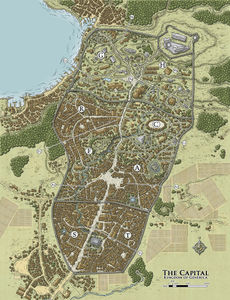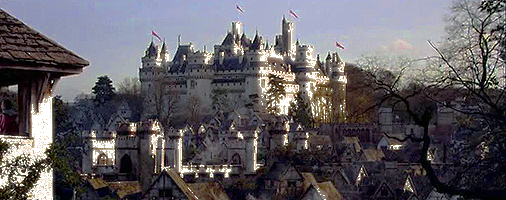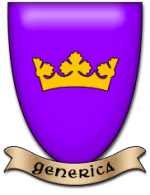Category:The Capital
| ||||||||||
|
| ||||||||||

| ||||||||||
|
| ||||||||||
|

The Capital is the capital (!) of the Kingdom of Generica. It is located a bit to the west of the center of the kingdom, in the province of Brightcastle, on the eastern edge of King's Lake. Castle Royal rests atop a hill at the northernmost point, overlooking the rest of the walled city. It enjoys a mild climate and life there is luxurious for those that can afford it, although it is not without its slums. The city is overpopulated and can be a little dangerous in spots, even in the best of times, despite being policed by a City Watch.
Contents
Tropes
Geography
Origin and History
The Capital was founded by King Jon I. He established a small wooden fort atop the hill where his army first encamped, and used this as a base for his campaign to conquer the region. Having achieved his goal, he established the new castle on the site of his original fort. The city expanded rapidly under his descendants. By the time of the Black Army, the city had a population of approximately a hundred-thousand people.
Government
Though the castle and its city fall under the direct desmene of the king, he does not normally involve himself in its day-to-day governance.
The city is governed by a council of elders, a group of technically coequal members who head various major interests within the city. The number of councilmen usally varies between 12 and 18, depending on the political circumstances. Replacement of an councilman who dies or retires is not required. If a vacancy in the council should be filled, the new member is chosen by vote of the current councilmen. The city council meets every Senday during the year to cover business relevant to the city. As he sees fit, he king may (rarely) attend himself, or send a representative (often, his steward) to attend the council meeting.
The city council periodically elects a Mayor from among its members to lead them. The election of a mayor occurs whenever the old mayor dies, retires, resigns, or fails a no-confidence vote consisting of a two-thirds majority of the council. The mayor acts as a liaison to the king in city matters.
The guilds of the Capital are all designed to protect and further the social and economic interests of their membership. While not all of the Guilds have been granted or have been able to maintain a monopoly on the services and crafts they provide, they can nevertheless present a united front to any form of competition and have a recognized degree of political influence with the city council. On the first days of each season of the year, the Grand Council of Guilds meets at City Hall. All the city's Guildmasters are required to attend (and must send deputies should they be unable to do so). This meeting is used to discuss petitions and legislation before the city council that may affect the trade or business of one or more of the city's guilds, and allegedly serves the purpose of granting those city guilds not directly represented in the council a say in the city's governance.
Economy
- Hub of trade
- Fishing in the lake; lake feeds into the Crown River down to the Imperial sea
- Hub of roads; King's Road connects north and south
- HQ of many guilds
Features
- Castle Royal, home of the Royal Court of Generica
- Guildhall of Heroes; Heroes' Guild HQ
- The Spire (outside town, just to the south, down the river); Wizards' Guild HQ
- Capital Cathedral (St. Prosylus' Cathedral of the Holy Pantheon); seat of the Archvicar of the Capital, Heirant Pompus
- City Hall
New City
- High Quarter
- Garden Quarter
- Foreign Quarter
Artisans' Quarter
This small quarter of the Capital is one of the most peaceful, lacking the wild taverns and crowds of most other districts. The Artisans' Quarter is home to hardworking people and their families. Consequently, a great number of different businesses can be found in the tiny Artisans' Quarter. While some of these artisans work for employers and travel to a different location for their job, the majority work in shops within their homes.
Its major features are the guildhalls for many of those craftsmen and women. The houses here are small. At first glance one might think they are crowded uncomfortably close together. Upon closer examination, the buildings all seem to fit snugly together, while leaving a surprising amount of space between them. The hallmarks of each tradesperson can be seen on the front of the house: an ornately carved balcony and railing for the woodcarver, a wide, sweeping stairway for the carpenter, an imposing facade of granite for the stonemason, and so on. Weavers, painters, metalsmiths, and the like use an example of their craft to decorate the front of the house--a tapestry, unusual color scheme, or metal rack of tools, for example.
Sure, the Artisans' Quarter has its share of taverns, but these are quiet, neighborhood places. Most of the customers recognize each other and the proprietor—who is usually the owner. Strangers are treated cordially, but any unruliness arouses the resentment of the entire establishment. The City Watch, while not a great presence here, is not neglectful. With its convenient location next to the Low Marketplace, the residents of this quarter rarely have to go elsewhere in the city for their needs. More than any other district, the Artisans' Quarter seems a self-sufficient community all unto itself.
Businesses: Shipper and Haulers, Brewers, Leatherworkers, Weavers, Tailors, Metalsmiths, Jewelers, Gemcutters, Furniture Makers, Carpenters, Stonemasons, Architects, and Taverns with food
Clerks' Quarter
The city district that houses the universities, colleges, and schools is referred to by two names: the "Clerks' Quarter," as a reference to the students, tutors, scribes, and clerks who live here in great numbers; and "The Halls," meaning the large, airy buildings that typically house the schools. Though it is not apparent from outside the quarter, the Clerks' Quarter is an area of plants, grassy yard, and small parks. It is second only to the Garden Quarter in the number and variety of its greenery. An interesting feature of the quarter is the outside seating, or veranda, available at most of the small taverns and eateries. It may be squeezed precariously between the building and the street, barely wide enough for a single row of tables, but this outdoor dining area is required of any successful eating establishment. In fact, the major attractions of this district to the citizenry of the city are these street-side tables. On Feast Days with nice weather, the streets swell with folk from all over the city, coming to enjoy their meal in the fresh air. The Millstream winds its way through the Clerks' Quarter, and much of its bank has been preserved as a grassy parkway. Students often come here to study or relax. It is not a thriving business district—most of the buildings not used for schools are the residences of students and instructors.
Businesses: Art Galleries, Bakeries, Boarding Houses, Book Binderies, Butchers, Inksellers, Launders, Leatherworkers, Locksmiths, Potters, Private Libraries, Scribeshops, Tailors, Taverns, Tiny Food Shops, Weaponsmiths, and Weavers.
Lake Quarter
This most riotous district is centered around the great curving avenue known as the Strip. With its taverns, brothels, gambling dens, and worse, the Strip at night is a cacophony of noises, a shadowland of flickering torches and blazing lamps. And always, day and night, it teems with drunks and toughs, lakemen and cityfolk. Always there are many who fight at any implied slight, and never are there enough patrols of the City Watch to keep the peace. People's Constables are common during the hours of daylight, especially near the Cargo Gate. There these tinpot enforcers of law and order nab many people just off the river, before they have a chance to adjust to city life.
Naturally, adventurers love it here. Lodgings are cheap, and news from the world beyond is plentiful. There are numerous merchants and innkeepers willing to relieve a traveler of his heavy load of treasure. Behind the Strip the Lake Quarter is a mixture of boarding houses and warehouses. While much cargo brought up the river is stored on the wharf, many small warehouses are offered for rental here as well. Cargo moves quickly in the lively economy of the Capital, so a load generally remains in a warehouse only for a week or two.
Businesses: Armorers, bakers, bawdy houses, boarding houses, boats/nautical equipment, boot maker/leatherworker, butchers, eateries, expedition suppliers, shipper and haulers, tailors, taverns, warehouses, and weaponsmiths.
Old City
- Thieves' Quarter
- Slum Quarter
City outskirts
- Barge End
- Shacktown
- Wharves
Other Locations
- Streets, Squares, and Gates
Notable Residents
- King Jon XVII
- Princess Damsel
- Válaris of Heroham
- [Mayor of the Capital]
Notable Institutions
- The City Watch
- Crown Guard; the King's bodyguard-retinue
- Thieves' Guild of the Capital
Rumour Has It…
Behind the Scenes
- Ripped off from D&D's "Free City of Greyhawk" (Ref2)
- Castle Royal "played by" Château de Pierrefonds, also used as "Camelot" in the TV series, Merlin
- The Capital is intended to be an equivalent to Tudor-era London in size and feel
- CK2: Considered a "fortress" (barony), though its castle-town is extensive/important enough to rival other proper "cities."
See Also
Subcategories
This category has the following 3 subcategories, out of 3 total.
Pages in category "The Capital"
The following 52 pages are in this category, out of 52 total.
